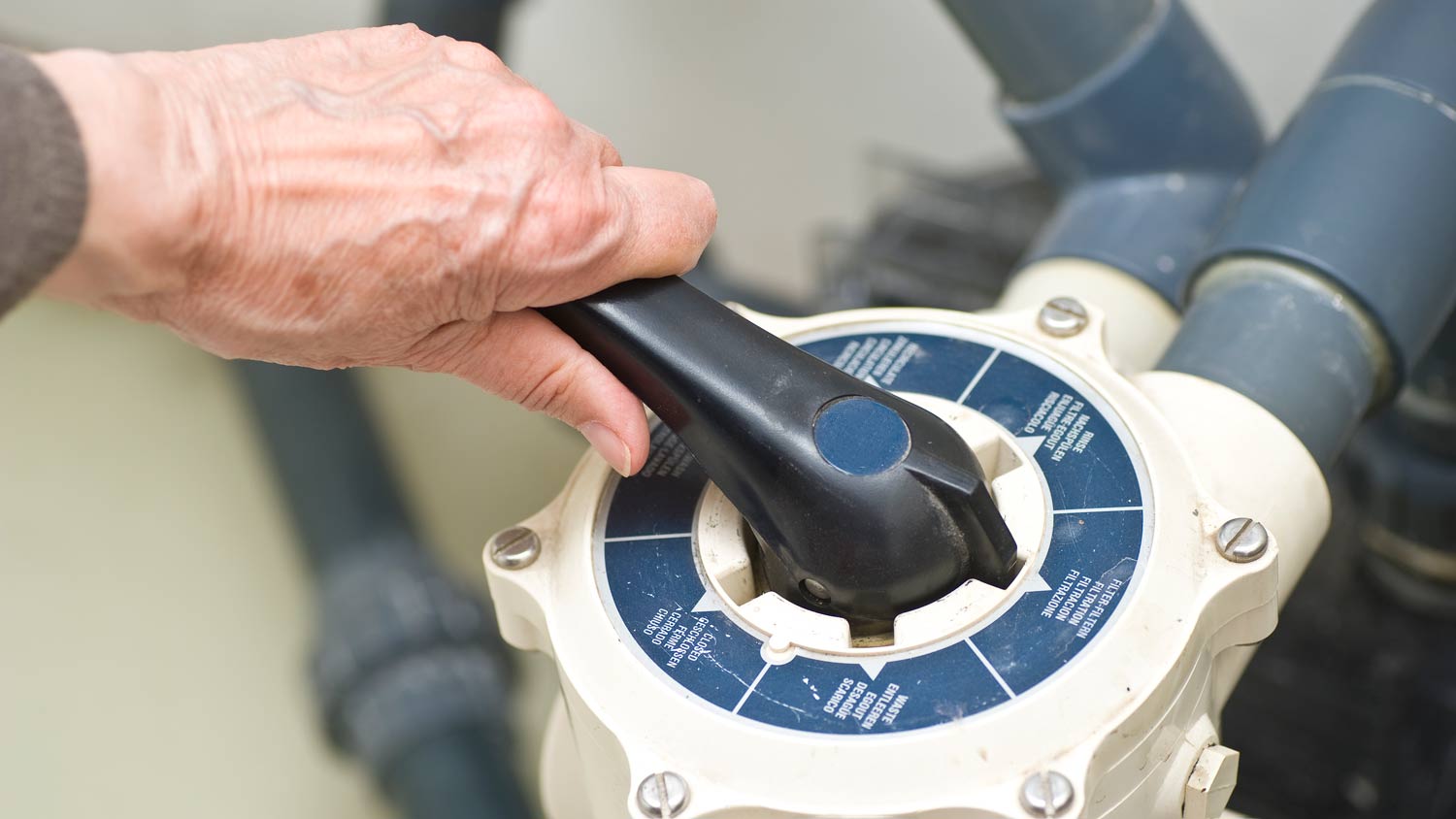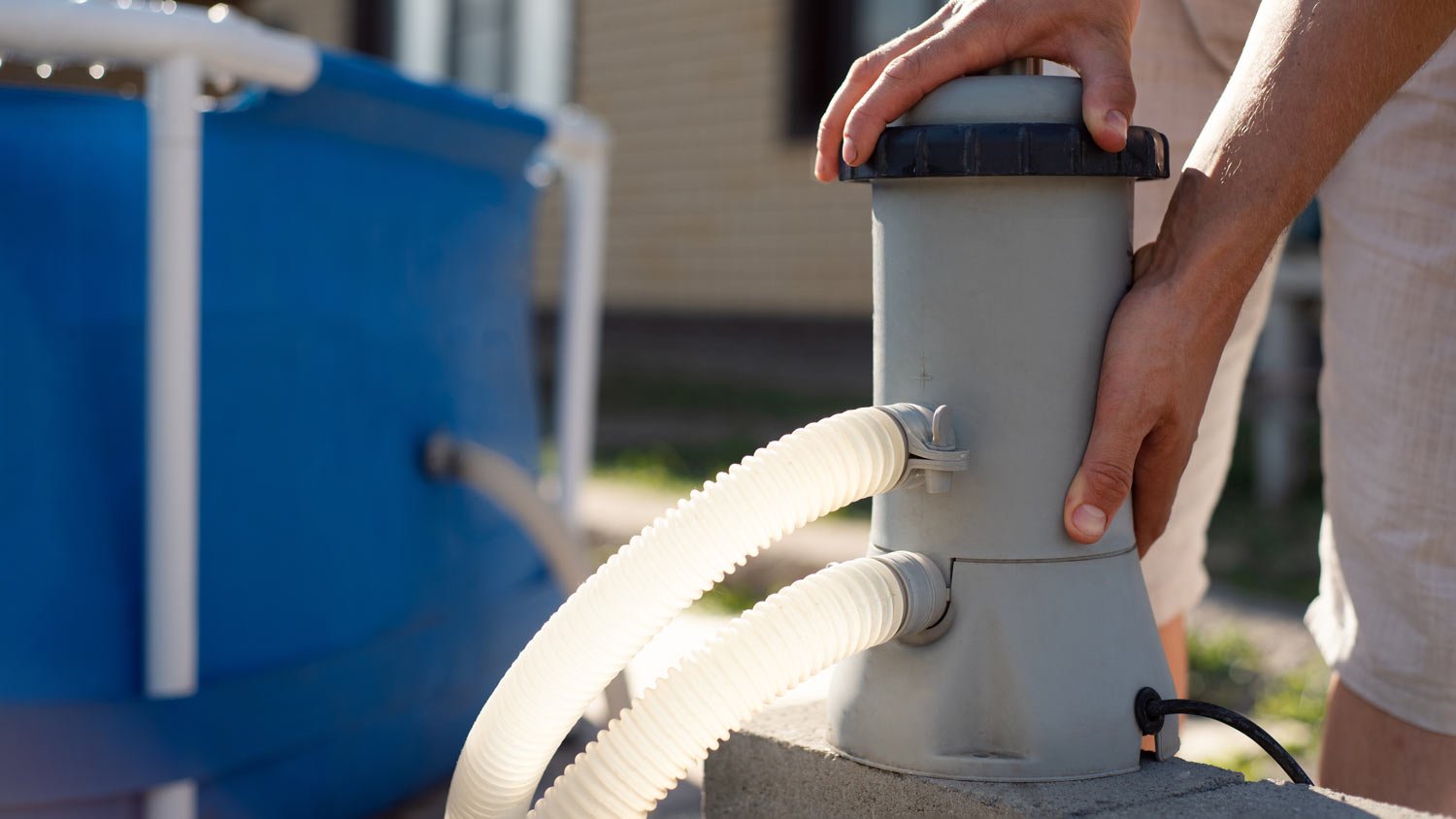How to Prime a Swimming Pool Pump in 6 Steps
It’s prime time


- Garden hose
- Bucket (optional)
- Pool plug removal tool
The pump is one of the most important parts of your pool system. It draws water in from the pool and moves it into the filter, where dirt, debris, oil, bacteria, hair, and more are removed. The water then flows back into the pool, where it will eventually circulate back through the pump and the filter. This cycle keeps the pool clean and ready for you to swim. This is why keeping your pump running smoothly is an essential part of pool maintenance.
The pump needs water to work properly, and you can ensure this by priming the pump before turning it on. Here are six easy steps for priming a swimming pool pump.
1. Turn the Pump Off
If the pump is on and needs to be primed, start by turning the pump off. If you’re just firing it up for the season, leave it off until you prime it.
2. Turn Multiport Valve to Recirculate

If you have a multiport valve, make sure it’s turned to recirculate. That way the water will flow from the filter back to the pool.
3. Remove Plugs
In order for the pump to work properly, water needs to enter the inlet pipe from the skimmers and return jets. To allow this, remove any plugs to allow for proper water flow. You may be able to unscrew them with your hand, but if it’s difficult to loosen them, you can use a pool plug removal tool.
4. Add Water to the Pool Pump Housing
Remove the lid from the pool pump housing and, using a garden hose, fill the pump basket with water. Replace the lid. You may need to do this step multiple times if the water flows back into the inlet side. You’re trying to get the pump to pull water from the pool, so it has to form enough suction to get the water to flow through the inlet pipe and into the housing.
5. Turn Pump On and Observe

Once the lid is back on the pool pump, turn the pump on. You should see the water get sucked out of the basket quickly followed by more water flowing in from the inlet side. You’ll know the pump is working properly when you see water splashing around inside as water is pulled in through the inlet pipe and then sent to the filter via the pipe on the opposite side.
6. Add More Water If Necessary
If you’ve done all of the steps and it’s still not running properly, you may need more water. Turn off the pump and more water to the pump basket and try turning it on again. If that doesn’t work, you can add water to the skimmers and try again. If you think you’re adding enough water and it’s still not working, it’s time to call in a pool repair pro near you and have them check it out.
Mistakes to Avoid When Priming a Swimming Pool Pump
Priming a swimming pool pump is a fairly simple procedure, but a few mistakes can create issues that could lead to major repairs.
Not adding water before turning the pump on: The whole point of priming the pump is to make sure there is water in it before you turn it on. If you assume that water will start to circulate, and you don’t add water to the pump, you could damage the pump.
Not removing pool plugs: Not removing the pool plugs in the skimmers or return jets can stop water from circulating into the pump, so even if you’ve filled it with water prior to turning it on, failing to remove the pool plugs can lead to damage.
Not calling a pro if there are issues: If you’ve followed these steps and your pool pump still isn’t working or you think there’s something wrong, a pro may be able to figure out what the problem is or repair the pump to avoid having to replace it completely.
When to Prime the Swimming Pool Pump
A swimming pool pump needs to be primed anytime it is empty. Typically, this will be at the beginning of the season before you turn it on for the year, but it could also need to be done after a pool repair or if the water level has dipped below the pump.
DIY Priming a Pool Pump vs. Hiring a Pro
Priming a swimming pool pump is a simple process and can definitely be a DIY job with a few caveats. If everything goes smoothly, you can likely prime the pump on your own, but if something goes wrong and you’ve tried troubleshooting to no avail, it’s probably time to call in a pool service pro. If you run the pump without water for too long, it can overheat and get damaged, which can cause the pump to fail. A pool service technician will be able to assess the pump and figure out what the issue is to avoid more damage.
Frequently Asked Questions
Pool pumps last between eight and 15 years. The actual lifespan will depend on the amount of maintenance you perform, the brand, and the size. If you forgo maintenance, don’t pair it with the proper filter, or ignore signs of a leak or other damage, the lifespan will be on the shorter end. Proper maintenance, including changing the pool filters regularly, replacing the motor every eight to 10 years, and choosing a variable-speed pump can help prolong its life.
A swimming pool pump has to have water in it to run properly. If the pump isn’t primed and tries to run when it’s dry, the components will overheat which can cause the pump to seize up and can even damage the PVC pipes that carry the water into and out of it. Essentially, running a pump that isn’t primed can lead to having to replace the entire pump.
A new pool pump costs an average of $1,300. The actual cost can range between $700 and $4,000 and will depend on the type of pump you have, the size of your pool, the brand you choose, and the cost to install it. Making sure the pump is primed can help you avoid needing a costly replacement pump.





- Swimming Pool Installation
- Pool Liner Replace & Install Companies
- Above Ground Pool Contractors
- Pool Remodeling Companies
- Inground Pool Companies
- Pool Removal Companies
- Inground Pool Repair Companies
- Sauna Companies
- Hot Tub Companies
- Sauna Repair
- Fiberglass Pools
- Pool Designers
- Pool Pump Repair
- Pool Closing Services
- Solar Pool Heater Installers








